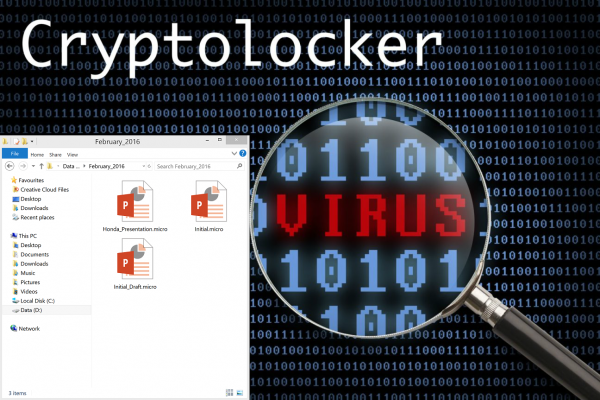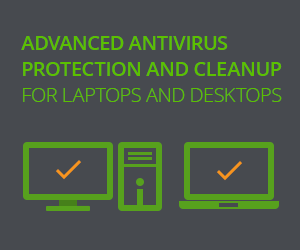Cryptolocker is an advanced crypto virus. Its copies infiltrate computer systems to hold the data encrypted for ransom. All files start to have the .micro extension. The encryption standard applied by the infection is virtually invulnerable to any decrypting attempts without the original encryption key.

The above does not encourage victims to purchase the key as prompted by the Cryptolocker ransomware. However, this article would not conceal the truth, either. The likelihood of decrypting data with .micro file extension by way of white-hat hacking is subtle.
A ray of hope shines to the victims as some variants of the Cryptolocker virus have been successfully cracked. IT experts managed to hack the server with decryption keys. The decryption tools have been dispatched to the victims.
The ransom virus propagates via sophisticated distribution networks. The ransomware makers abstain from dropping its copies into computers directly. They offer the virus for propagation on affiliate terms. The offers are in abundance at dark net forums.
The developers of Cryptolocker communicate with potential distributors via TOR and VPN protected channels. The anonymity of parties is ensured.
A distributor of Cryptolocker ransomware may adjust the amount, installation and behavior patterns of the infection. The developers do not recommend setting an excessive amount of payment. However, even one Bitcoin is a certain sum of money.
Paying the ransom is not the best option. Moreover, cases have been reported of the Trojan failing to dispatch the decryption key correctly. The victims, despite satisfying the hacker’s demands, failed to restore access to their valuable data.
The distributors of the ransomware may inject the virus immediately into the corporate network and encrypt and add .micro file extension to all types of files. If that is the case, they tend to adjust the infection so that it would encode each machine individually. That enables the ransomware to claim payment for decrypting each affected device. Imagine a corporate network of hundreds of computers to grasp the scale of the scam.
The distributors are not restricted in opting for Cryptolocker infection vector. The above scenario is but one of the multiple options.
Removal of Cryptolocker Trojan is a must. Whether you pay the ransom as prompted, the malware remains at your PC until after you get rid of Cryptolocker installed components. Proper recovery and removal guidance follows.
Automatic removal of Cryptolocker ransomware and .micro files restoration
The benefits of using the automatic security suite to get rid of this infection are obvious: it scans the entire system and detects all potential fragments of the virus, so you are a few mouse clicks away from a complete fix.
- Download and install recommended malware security suite
- Select Start Computer Scan feature and wait until the utility comes up with the scan report. Proceed by clicking on the Fix Threats button, which will trigger a thorough removal process to address all the malware issues compromising your computer and your privacy.
Unlock .micro files encrypted by Cryptolocker virus
Cryptolocker represents a unique category of malicious software whose attack surface reaches beyond the operating system and its components, which is why removing the virus itself is a part of the fix only. As it has been mentioned, it encrypts one’s personal information, so the next phase of the overall remediation presupposes reinstating the files that will otherwise remain inaccessible.
-
Launch data recovery software
Similarly to the rest of its fellow-infections, Cryptolocker most likely follows an operational algorithm where it erases the original versions of the victim’s files and actually encrypts their copies. This peculiarity might make your day, because forensics-focused applications like Data Recovery Pro are capable of restoring the information that has been removed. As the virus further evolves, its modus operandi may be altered – in the meanwhile, go ahead and try this.
-
Take advantage of Volume Shadow Copy Service
This technique is based on using the native backup functionality that’s shipped with Windows operating system. Also referred to as Volume Snapshot Service (VSS), this feature makes regular backups of the user’s files and keeps their most recent versions as long as System Restore is on. Cryptolocker hasn’t been found to affect these copies therefore the restoration vector in question is strongly recommended. The two sub-sections below highlight the automatic and manual workflow.
- a) Use Shadow Explorer
Shadow Explorer is an applet that provides an easy way of retrieving previous versions of files and folders. Its pro’s include an intuitive interface where the computer’s entire file hierarchy is displayed within one window. Just pick the hard disk volume, select the object or directory to be restored, right-click on it and choose Export. Follow the app’s prompts to get the job done.

- b) Use file properties
Essentially, what the above-mentioned Shadow Explorer tool does is it automates the process that can otherwise be performed manually via the Properties dialog for individual files. This particular approach is more cumbrous but just as effective as its software-based counterpart, so you can proceed by right-clicking on a specific file, which has been encrypted by Cryptolocker, and selecting Properties in the context menu. The tab named Previous Versions is the next thing to click – it displays available versions of the file by date of the snapshot creation. Pick the latest copy and complete the retrieval by following the prompts.

-
Data backups work wonders
Ransomware like Cryptolocker isn’t nearly as almighty and destructive in case you run regular file backups to the cloud or external data media. The virus itself can be completely removed in a matter of minutes, and the distorted information can then be just as easily recovered from the backup. Luckily, this is a growing trend, so ransom Trojans are hopefully going to become less subversive in the near future.
Verify thoroughness of the removal
Having carried out the instructions above, add a finishing touch to the security procedure by running an additional computer scan to check for residual malware activity
